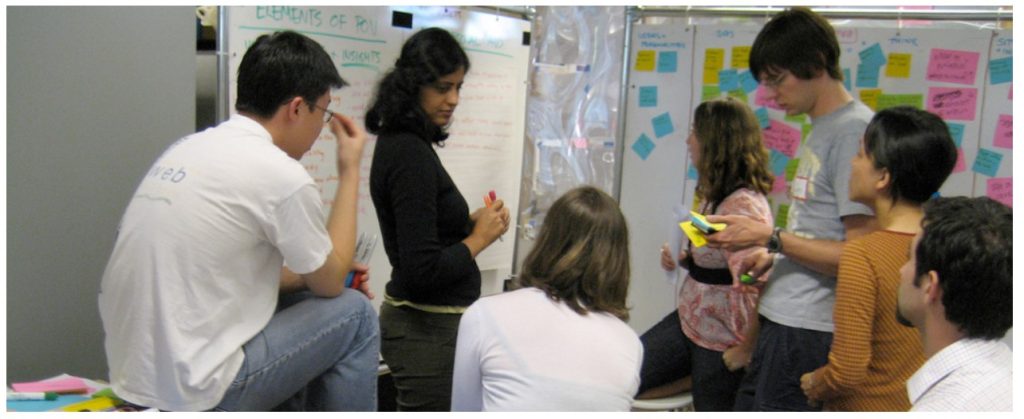5 Brainstorming
Frances Davis and Hasso Plattner Institute of Design at Stanford
Brainstorming
The goal of brainstorming is to generate a large quantity of diverse ideas in response to the design project you have identified and then select a subset of ideas (two to five) you want to explore further. Brainstorming works by leveraging the collective thinking of the group — engaging with each other, listening, and building on other ideas. Conducting a brainstorming session also creates a distinct segment of time when you intentionally turn up the generative part of your brain and turn down the evaluative the part. Brainstorming can be broken down into three phases: preparation, brainstorming and capture, and application of constraints.

Prepare
Begin by figuring out where you will brainstorm. You first should decided if you will work in person or virtually. If working in person, you can use the MakerSpace which has space for you to capture ideas where you can be close to each other and all see what is happening. If you are planning to work virtually, Google JamBoards work well to allow everyone to see what ideas are being added. The goal of this step in preparation is to make a plan and pick a place so you can ensure everything is ready when you start your session.
Prepare intriguing How-Might-We (HMW) questions for the brainstorm. Having the ‘right’ questions is probably is most important factor for creating innovative ideas.
How Might We Questions
“How might we” (HMW) questions are short questions that launch brainstorms. The goal is to create questions that are broad enough that there are a wide range of solutions but narrow enough that the team is provoked to think of specific, unique ideas. For example, between the (possibly) too narrow “HMW create a cone to eat ice cream without dripping” and the too broad “HMW redesign dessert” might be the properly scoped “HMW redesign ice cream to be more portable.” It should be noted, the the proper scope of the question will vary with the project and how much progress you have made in your project work.
Brainstorm & Capture
At the beginning of your session the goal is to capture every idea. Everyone can take turns sharing ideas as they add them to board. This technique tends to keep everyone engaged. If people start to riff verbally off others’ ideas, that’s a good sign. Make sure to write those ideas down too. If you need to have 2-5 ideas at the end of your brainstorming session try to fill your board with 15+ ideas!
If you need help to get started with ideas, take one of the HMW questions you developed in the preparation stage and write it on the board. Take turns putting up solutions that address the question.
Don’t be afraid to throw in crazy ideas or ideas that won’t work. Seeing what does not work with these ideas can often lead you to an idea that will work!
Rules for Brainstorming
- Have one conversation at a time. Focusing the conversation makes sure everyone participates and that problems are addressed before moving on.
- Go for quantity. You want a lot of ideas to choose from and you want to be able to identify what makes certain ideas good. The more ideas you have this easier it will be to choose from the list.
- Encourage wild ideas. Too often brainstorming stays in safe and practical territory. Your challenge in brainstorming is to get comfortable offering stupid ideas AND building on those ideas, not just treating them as throwaways.
- Build on the ideas of others. Building on ideas allows you to harness the power of your team to improve and refine ideas as you go along.
Apply Constraints
Use varied criteria to select ideas, such as: the sure bet and the long-shot. Have team members independently mark the top ideas on the board. Good constraints often spur new ideas. Novel ideas come from specific topics and from responding to constraints. Consider any constraints imposed by design project (time, access to materials, etc.) and use them to help you identify the most promising solutions from your brainstorming session.

